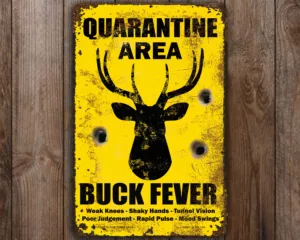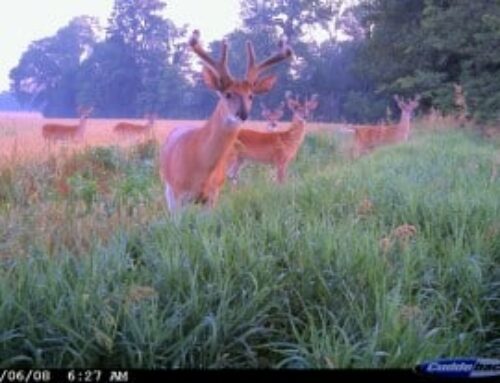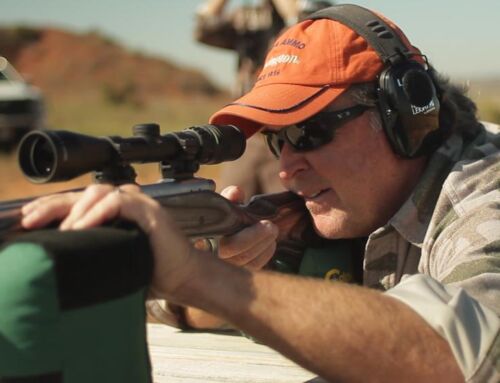 Here’s an 8-step plan for staying cool and collected, and making all the right moves when a big buck is close.
Here’s an 8-step plan for staying cool and collected, and making all the right moves when a big buck is close.
- Set up smartly. Play it smart before you lay eyes on a big deer. Do you normally hang a tree stand 18 to 20 feet high? Well, move it on up to 22 feet when archery hunting. A little extra elevation lets you get away with a lot more movement (which we will discuss later) when a buck approaches. Also, if you shoot right-handed, angle a perch on a tree so that your left shoulder points toward a spot where you expect to see deer (vice versa for southpaws). If a buck shows there, you can stand up and draw a bow or raise a gun with little movement. And your body and feet will be in good shooting position.
- Be Ready. Climb up and organize your gear. If you’re right-handed, hang a bow on a hook or set it in a bow holder within inches of your left hand. Don’t lay a gun across your lap; rather, sit with it tucked on a thigh and between your knees. Hang your binocular, range finder, rattling horns and other stuff on hooks within easy reach. The point is, get organized before a buck shows. You’ll fidget less and won’t get busted.
- Look and Listen. It’s tough to stay on read-alert, especially when it’s cold and you haven’t seen a buck for hours or maybe even days. But you gotta stay sharp. The minute you drop your guard, presto! A dominant buck will pop up within 50 yards of your stand and you don’t want that. When a big buck surprises you, you might get rattled, make a fast move and spook him. So methodically scan the woods and try to pick up the flash of antlers or hide as far out as possible. You’ll have time to calm your nerves, shift into position and start planning your final moves.
One time I hunted for 3 days in Saskatchewan and never saw a buck. Six hours into the fourth day I heard a branch crack, then one snort. I raised my .270 in the nick of time to shoot a 150-inch non-typical that raced past my stand. It can happen that fast, so look and listen for bucks. One good thing about a quickie hunt is that you don’t have time to get buck fever. If you’re ready, you just react and shoot.
- Watch a Buck. Let’s say you spot a huge buck 150 yards out, angling toward your stand. Do not, I repeat, do not take your eyes off the deer. If you look down at your bow or gun for just a second you might look back up and he’ll be gone, down in a ditch, behind a hump, whatever. It might take you a couple of minutes to find the buck again. Heck, you may never see him again.
Try a sort of double vision. Watch a buck with one eye and with your other eye look 20 yards ahead of him for holes in the cover to shoot. Start planning a shot as far in advance as possible.
Also, read a buck’s body language. Things are good when a big deer strolls along with his head down. But if a buck is alert and nervous, looking all around, you’ve got to be extra careful. He’ll bust you in a second.
- Don’t watch a rack. A surefire way to catch the fever and shakes is to spot a giant buck and then gape at his rack. The more you count tines, gauge mass and guesstimate score, the more your heart pounds. You start to hyperventilate. Your legs turn to jelly. The closer a buck comes, the bigger his rack looks. Keep watching it and you might lose it!
Once you spot a shooter, don’t look at his rack again. Pick a spot of hair on a buck’s side and watch that instead. It helps you stay calm and get ready for the shot.
- Move when you can. When you spot a buck a good way off, grab your bow and stand up slowly. You’ll probably want to sit in a stand and shoot a gun, so simply twist your body in the deer’s direction.
When a buck pops out of the cover within 100 yards, be careful. But not too careful. The second he turns his head away or sticks it behind a tree or patch of brush go for it. Move smoothly and quietly, but don’t be tentative. You’ve got to get into shooting position early, before a buck gets tight and pins you down.
- Freeze if you have to. If a buck looks your way freeze! He might have spotted a flicker of movement, or whiffed a few of your scent molecules or simply sensed that something is amiss. Whatever, he’s wired and ready to bolt. Wait until the deer settles down and drops or turns his head before moving again. If he stays wired, stay frozen. You might have to let him walk past or beneath your stand. Make your final move as he quarters away.
- Close the sale. So far so good. You’re sitting pretty with a muzzleloader or rifle pointed at a wall-hanger. Well, what are you waiting for? Take a deep breath and take the buck as soon as he is in range and you have a clear view of his heart/lung vitals. Every second that you wait, the chances of something going wrong are magnified. Shoot when you can!
An archer must be slick when a big deer is inside 30 yards. Don’t draw your bow when a buck is quartering on. He’ll look up and bust you. Wait until he turns broadside or walks away. And don’t pull the string until he looks away or runs his head behind a tree or brush. Bore your eye through the peep and onto that spot of hair you’ve been watching all this time. Aim just behind a buck’s front leg and a third of the way up his body. Take a deep breath. Focus on a smooth release and total follow-through. Keep watching that hair patch until your arrow’s fletching disappears into it.
A deer shot through the lungs with a bullet or a broadhead won’t go far. Climb down, find him and wrap your hands around that massive rack. Come unglued if you want to. Now is the time to catch a case of buck fever.





